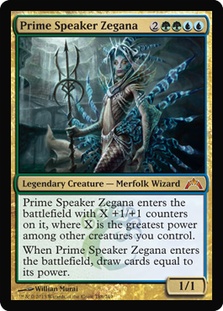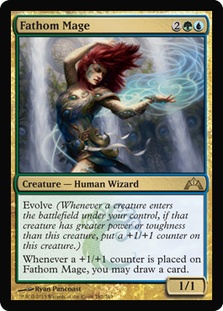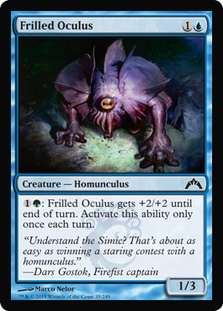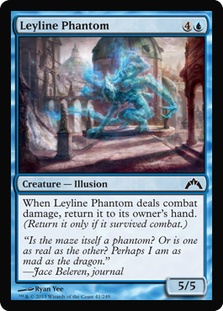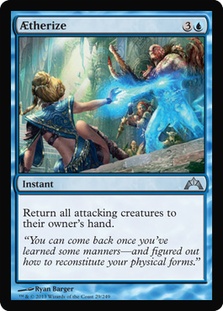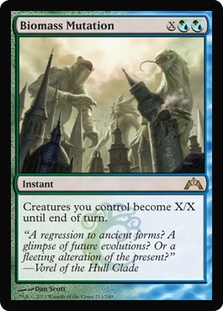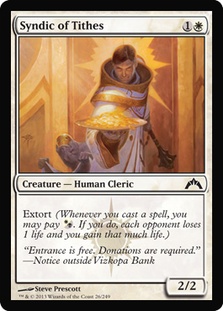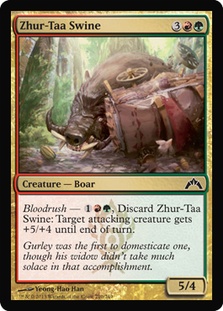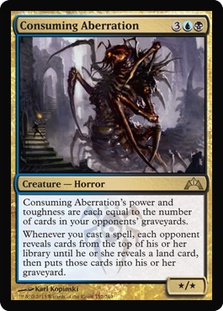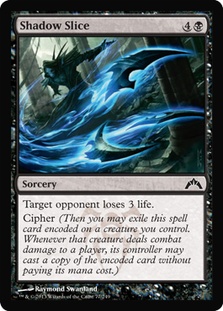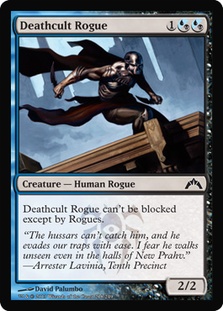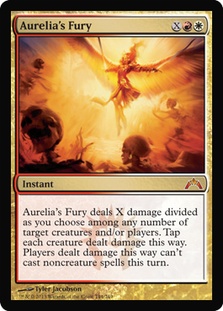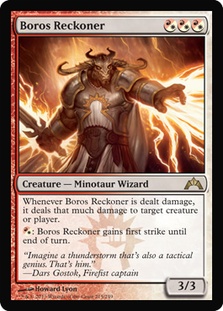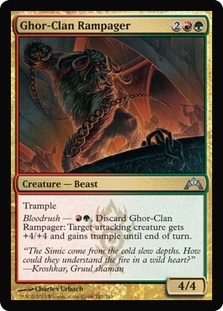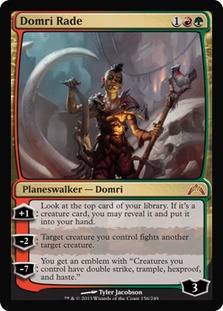Like the rest of you, I spent my Saturday this past weekend playing with Gatecrash for the first time. I was spellslinging at Thou Shalt Game in Temecula, CA, where I had a blast representing the Simic Combine as I said I would in my primer article last week. While that article discussed my thoughts about each of the guilds going into the Prerelease, this week I’ve actually played with the cards and have a lot more information to work with, and I’m going to talk about my experiences with the set and how I see things playing out moving forward.
One disclaimer before we get started: I haven’t played with Gatecrash cards in Standard yet, and when I do, I’m not going to talk about them. Until after Pro Tour Gatecrash, that is. Once I start testing for the tournament, I’m going to have information that I’m not going to feel comfortable sharing for fear of hurting the chances of my test group and myself in the event. I don’t want to feel like I have to hold anything back since that seems somewhat disingenuous, so I’d rather just put a moratorium on talking about Standard until after the PT. Thankfully, there are other formats in Magic to discuss, and one of them got quite the facelift from bannings this week.
Anyway, back to Gatecrash. As I mentioned before, I chose Simic for the event. My guild booster was pretty solid, bringing me a Prime Speaker Zegana to go with my Fathom Mage for serious card drawing power, and I had what seemed like an excellent curve of evolve creatures. I was a little light on spells, but I wasn’t really worried about it. Going into the event I’d anticipated that creature-heavy decks would be the norm for several of the guilds thanks to evolve, battalion, and bloodrush all giving extra incentive to play more creatures than is typical in Limited.
Here’s what I ended up playing:
Creatures (17)
- 1 Fathom Mage
- 2 Drakewing Krasis
- 2 Crocanura
- 1 Prime Speaker Zegana
- 1 Leyline Phantom
- 2 Shambleshark
- 1 Slaughterhorn
- 1 Clinging Anemones
- 1 Frilled Oculus
- 1 Adaptive Snapjaw
- 1 Crowned Ceratok
- 1 Ivy Lane Denizen
- 1 Nimbus Swimmer
- 1 Greenside Watcher
Lands (17)
Spells (6)

The deck was extremely impressive…sometimes. Simic seems to suffer from the need to draw your cards in a particular order for them to function as intended. Shambleshark into Crocanura into Crowned Ceratok is quite the explosive start, but any missing piece makes the lot of them that much less effective. You can certainly do awesome things, but they’re at the cost of substantial inconsistency in the way your deck plays out.
In some formats, that inconsistency wouldn’t be a huge deal. After all, if you draw a Crocanura after you’ve already played out all of your creatures that could evolve it, you still have draw steps to find a buddy who can grow him. The problem is that Gatecrash is a very fast and very swingy format and you frequently don’t have the time to wait for your little sea monkeys to grow. Boros can run you over with battalion, Gruul can crush you with big monsters, Dimir can finish you off with unblockable cipher creatures, and Orzhov can just pick you apart with extort while you’re trying to piece together your little army.
Evolve definitely leads to a lot of interesting gameplay decisions, though. Should you play your Drakewing Krasis on turn 3 to apply pressure, or should you wait until turn 4 so you can evolve your Crocanura? Or turn 5 so you can draw a card off of your Fathom Mage? But wait, you drew a two-power creature—should you wait another turn so you can save the Krasis to evolve your Fathom Mage a second time? These situations all came up for me multiple times, and I’m not sure even now whether I made the right decisions.
The basic gameplay of evolve aside, I was definitely impressed by some of the Simic cards in my deck. Frilled Oculus was quietly an all-star, providing a solid body for blocking early creatures that could easily go aggressive and get meaningful damage in. As a 1/3 for just two mana, it’s also an excellent follow-up to a Cloudfin Raptor or other early evolve creature. I expect it to be an important role-player in Simic Draft decks over the life of the set. Crocanura was similarly excellent and provides much-needed defense against fliers while also growing into a real threat in the mid to late game.
Drakewing Krasis was also better than I have expected. A cheap high power flier might seem like it would obviously be good, but the fact that it has three power for three mana helps significantly with your evolve chain. It also provides a solid way to actually win the game, which is sometimes difficult once the ground gets gummed up against Orzhov or Gruul. While I didn’t have any of them in my pool, I expect Cloudfin Raptor to be a very high pick in Draft as a cheap evasive threat that can give both Simic and Dimir a way to break through, though I expect Dimir to want it more thanks to cipher.
Leyline Phantom was better than one might expect. A 5/5 body for five mana with a drawback may not seem like such an amazing deal, but it’s great at evolving just about anything else you might have in play. Returning to your hand post-combat can actually serve as a bonus, too, since you can attack with it and replay it to evolve your team again. Always be on the lookout for ways to turn an apparent drawback around!
Amongst my few spells, Rapid Hybridization was surprisingly good. There are a lot of solid creature enchantments in the set like Gift of Orzhov and Madcap Skills, and being able to deal with them for one mana at instant speed is huge. Similarly, bloodrush means there’s an inordinate number of combat tricks in the set, so having the ability to break up what an opponent thinks will be a devastating attack by turning their creature into a Frog can be backbreaking.
I had an opponent use the +5/+4 bloodrush creature on an unblocked attacker to try to kill me when I had only a single Island untapped, and he was certainly not happy to see his creature go all mutant on him. I wouldn’t want a bunch of them since it’s not real removal and has diminishing returns in multiples, but I think I’d almost always want to have one and maybe two.
Aetherize was also situationally very impressive. It’s worth noting that multiple guilds in Gatecrash have mechanics that make this card particularly devastating. Simic loses all of their evolve counters on the creatures that were bounced, and Dimir loses their encoded spells. Gruul can run headfirst into it with bloodrush, while Boros—well, let’s just say resolving Aetherize against a battalion-enabled attack feels really, really good. I actually had one game where I managed to bounce three attacking creatures, one of which my opponent had just enchanted that turn, leaving him unable to even replay any of them. I managed to win that game.
On the other side of the coin, Fathom Mage was rather disappointing. The problem with it was the play order dilemma I mentioned earlier. Once you get to four mana, you’ve already played out a few creatures, leaving you with less fuel to evolve your Mage. Even if you have the tools to evolve it, you’re probably going to draw maybe two cards in most games, and the opportunity cost of playing a 1/1 on turn 4 in this very aggressive format is huge. While it’s certainly a fun card to play with, my inclination is that it won’t be a particularly high pick in drafts going forward.
My other rares, however, were quite good. Prime Speaker Zegana was about as powerful as you’d expect. On multiple occasions she drew me seven or more cards, mostly thanks to Adaptive Snapjaw. Unsurprisingly, a huge creature that comes with an entirely new hand tends to win games. Biomass Mutation wasn’t quite as consistently awesome but was certainly dramatic when it came up. Turning all of your creatures into 7/7s can win games in spectacular fashion. I expect that the Mutation will be a strong card in Sealed, where the games are slower, but probably less so in draft, where you’ll need cards that can compete with the speed of strong Boros decks.
Speaking of Boros, it was the guild that seemed the strongest to me from my experiences at the Prerelease. Many of their battalion cards are extremely powerful and unlike Evolve don’t care about what kind of creatures you draw to go with them. All they need is for them to be able to attack. Wojek Halberdiers and Daring Skyjek give Boros decks a pair of common three-power attackers—with abilities, no less, not drawbacks. Once a Boros player gets battalion online, they can frequently just keep turning their creatures sideways until you’re dead. Even if they fail to kill you right away, they can always fall back on their Orzhov buddy Syndic of Tithes to finish you off—a Boros card that made its way into the wrong guild if there ever was one.
My inclination is that Orzhov feels like the next best guild. Extort is a very powerful mechanic. My experiences playing against it felt like exactly what I imagine WotC was going for when they designed it—the semi-helpless feeling of getting bled out and there being little you can do about it. My guess is that Orzhov is a particularly bad matchup for Simic because both decks want to sit back and build up but Orzhov gets to nickel and dime Simic out as you’re trying to set up your evolved team.
Gruul looked fairly solid, but it didn’t seem like there were very many good reasons to actually play it. Most of the good Gruul cards are just bloodrush creatures, most of which can and will easily fit into Simic or Boros decks. Unlike evolve and extort, there’s not a real payoff for dedicating your deck toward the mechanic—it’s just generically good, so other players will take your good middle pick green and red bloodrush creatures. The only really impressive Gruul common is Zhur-Taa Swine, which doesn’t seem like nearly the same incentive that the other guilds have to play them.
Lastly is Dimir. I felt going in that I didn’t really have a solid grasp of Dimir, and now having played in the Prerelease I don’t feel much differently. My prediction that the Dimir guild promo was the best panned out I think—Consuming Aberration was incredibly impressive every time I saw it in play. I feel a little more comfortable evaluating cipher now that I’ve seen it in action, and I’m a bit more positive than my initial impression. Shadows Slice in particular really impressed me since it represents a huge chunk of someone’s life total if you manage to cast it and connect.
I get the feeling that Dimir decks are going to be heavily reliant on Deathcult Rogues, both for getting in enough damage to finish someone off with Shadow Slice and for enabling the rest of their cipher cards. I could see Dimir running into much the same difficulty as Gruul, though, in that the actual multicolored cards at common aren’t that great and you run the risk of seeing your best commons—like Rogue and Shadow Slice—poached by other guilds. Rogue may be difficult enough for other decks to cast that it goes late, but it’s very close to just a 2/2 unblockable creature, so I can see people picking it up regardless.
I feel like I have a lot to learn still about Gatecrash Draft, and I’m looking forward to getting a chance to draft it starting with this weekend. Have you found any particular guilds or cards that stand out to you? Let me know in the comments.
As for Constructed, my initial thoughts are that the set doesn’t seem to have a ton of cards that are likely to have a big impact. I’m pretty sure that Aurelia’s Fury is being massively overrated—it’s certainly a solid card, but it needs the right shell for it to work, which is probably something like an aggressive Naya deck. The biggest effect of the card, in my opinion, is the ability to tap all of your opponent’s creatures. It’s pretty much a Falter / Fireball split card, and that kind of effect wants to go in a deck with sizable creatures. I don’t see why people are trying to fit it into control decks by any means—it’s definitely not a big game-ending spell like Sphinx’s Revelation.
I actually only realized when someone played it against me at the Prerelease that Obzedat costs five mana. I thought it cost six for the longest time, and I’m certainly much more excited about it knowing that it can come down a turn earlier. It’s still a five-cost creature that doesn’t stop Falkenrath Aristocrat or Thundermaw Hellkite, so it’s a little hard to get too excited about it. Of the other guild leaders, Prime Speaker Zegana and Aurelia both seem somewhat exciting, but they are both getting close to Angel of Serenity levels of mana, which is a hard card to compete with in big creature mirrors.
One of the cards that excites me the most that seems to have flown under a lot of people’s radars is Boros Reckoner. This is one of those cards that make me annoyed at hybrid mana costs. Would WotC ever print a 3/3 with these abilities at RRR? I certainly doubt it. Hell, the original Guildmages came out at a time when red couldn’t even get a 2/2 for RR. Somehow, hybrid mana is an excuse to make more powerful cards than you’d make for either mono-colored cost, and yet they’re even easier to cast!
I get that making hybrid cards less powerful than their mono-colored counterparts would make them pretty unexciting, but it certainly seems strange to make them both more powerful and easier on the mana. In any case, Boros Reckoner seems like a very powerful card for Mono-Red Aggro. I’m not sure if it’s better than Pyreheart Wolf at getting damage through opposing creatures, but I know it’s a card that certainly scares me since it’s a huge pain to block and doesn’t even die to Ultimate Price—yet another way it’s better than its mono-colored pals.
While I’m generally underwhelmed by Gruul’s Constructed offerings in the set (Signal the Clans? Really?), I am excited for Ghor-Clan Rampager. He provides a quality body along with a very welcome ability for any kind of aggressive green deck. Being able to play creature-based combat tricks definitely makes Domri Rade more appealing, though the jury is still out on just how much it’s worth skewing your deck to fit that guy. He seems like he’d be excellent in a deck with resilient threats because a lot of his value is in his fight ability, but sadly the mana can’t possibly work to fit him into the Ooze deck. I’m sure I’ll build at least a few decks trying to find a home for him, though—he’s exactly my kind of card.
Anyway, that’s it for now. I’ll be back next week.
 |
We are Selesnya. Whatever we need to do can be done with creatures. Knight of the Reliquary, Qasali Pridemage, Thalia, and friends don’t flinch in the face of any opposition. Together we will conquer. |

